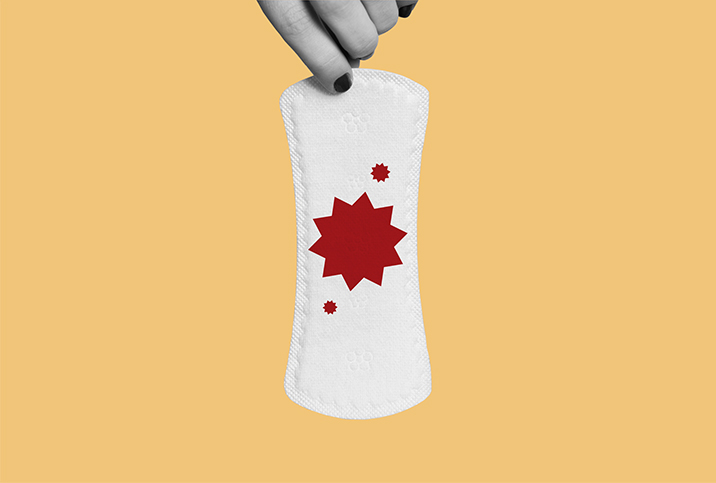Your Menstrual Clots Are Likely Normal

In 2020, Sophie started a new contraceptive pill. She had previously used an intrauterine device (IUD) but decided not to continue with that particular birth control because it kept giving her infections, such as bacterial vaginosis (BV). When she started her new combined pill, it made her periods very heavy and she started getting some enormous menstrual clots.
"I started getting clots after a few weeks, and they got bigger quite quickly," said Sophie, a 28-year-old from London. "I always used to get clots anyway, but I was getting a lot of pain [this time] and I realized that when I got that pain, it was a clot that was coming out. They were the size of my palm; I held them in my hand."
Sophie revealed photos of the clots, indeed, sitting in the palm of her hand. She looks like she plunged her hand into a bowl of blackberry compote before cupping it in the center of her palm: thick, black clumps glistening on a bed of bright red blood. In the background were large drops of dark blood in the bath below her hand.
What exactly are menstrual clots?
Menstrual clots can be (at best) mystifying or (at worst) absolutely terrifying, depending on their size and frequency.
When I was about 15, I remember lying in bed while on my period feeling like I was trying to push a spongy, clumpy tennis ball out of my vagina. I eventually went to the bathroom, and when I pulled the toilet paper away, I found a thick clot that was roughly the length and width of the tennis ball I'd been imagining. It was so dark it was almost black, and I stared at it with a gruesome sort of fascination before flushing it away.
"When you have a period, your uterus sheds its lining," said reproductive health specialist Sophia Yen, M.D., co-founder and CEO of Pandia Health and medical advisor to the Body Agency in Sunnyvale, California. "The menstrual clot is blood and some tissue [from] the lining."
"Menstrual clots are a sign that a woman is bleeding heavily," said Nanette Santoro, M.D., a professor and the E. Stewart Taylor chair of OB-GYN at the University of Colorado in Denver. "Menstrual blood is designed not to clot. The uterus bleeds, but along with the blood comes agents that break down blood clots. So, as the blood is getting ready to be expelled, it's pretreated with fibrinolysis that breaks down the clot. When women are bleeding too quickly for the menstrual blood to get treated by the clot-dissolving molecules, the blood clots."
When to see a doctor
Santoro described menstrual clots as "a variation of normal," while Yen pointed to a 2011 Brazilian study that analyzed the menstrual experience of women ages 18 to 45 and found 54 percent of women reported clots.
Menstrual clots certainly aren't unusual and often are no cause for concern, but there are instances in which it would be worth seeking a doctor's opinion.
"Women who pass many [clots] are likely to be bleeding more than average and may be at risk of anemia, or they may have a structural problem with the uterus that is causing heavy menstrual bleeding," Santoro said. "Menstrual bleeding that is causing a woman to change a pad or tampon every two hours for more than a day is enough to alert her that she should be checked out."
Yen advised seeing a healthcare professional if you have clots the size of a golf ball, you're changing your pad or tampon every hour, or you bleed for more than seven days in a row.
It's possible that large menstrual clots could be caused by uterine obstructions. Causes of uterine obstructions vary but can include fibroids, endometriosis, adenomyosis and—in very rare cases—cancerous tumors.
Sophie uses menstrual cups rather than tampons or pads, but when she was experiencing enormous menstrual clots, she changed her cups constantly.
"A whole clot would basically fill my Mooncup," she said. "I'd start to feel a cramp and I'd [think], 'I need to run to the bathroom,' because [the clot] would just fill the cup instantly, and if you've already been bleeding into the cup, it will obviously just overflow dramatically."
Sophie certainly knew when she needed to see a doctor.
"The [clots] were scary, [due to] the rate at which they were coming out and how enormous they were," she said. "I was like, 'What is coming out of me? This is awful!'"
Her fears were understandably further exacerbated by a history of anemia.
"I've been anemic in the past from having heavy periods, and I am at the moment," she said. "I'd [feel] faint and woozy, and [I'd get] headaches. So I knew I was losing a lot of blood, because I was feeling like that."
Sophie's doctor advised her to come off this particular pill straight away. Sophie has stayed away from any contraception since 2020, until recently when she started a new pill. She hasn't experienced any menstrual clots since getting off the initial one.
Managing menstrual clots
For the most part, clots are an annoyance and an inconvenience, but not something to be concerned about.
"[They] can make all forms of menstrual hygiene a challenge," Santoro said. "Clots that form over a tampon cause all the blood to trickle around the tampon and render it just about useless, because it can't do its job and absorb the blood."
Santoro advised women who pass clots regularly to try pads or menstrual cups, because they collect clots but do not absorb.
"It was gross, it was scary, it made me very anemic very quickly; it wasn't nice," Sophie concluded about her experience with menstrual clots.
We hear that, and we suggest seeking medical advice if you're at all worried.




















